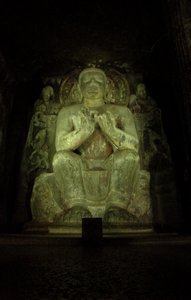Advertisement
Published: October 9th 2009

 Photo 10
Photo 10
A Buddha image within one of the cave's inner sanctumsMy first journey on the Indian railway network went off without any hitches. Punctuated by the frequent cries of 'chai-wallah, chai-wallah, chai chai chai', our train worked its way slowly out of the sprawling mass of Mumbai and into the Maharashtra countryside, arriving in Aurangabad in the evening. My reason for travelling east, besides escaping Mumbai, was to visit two of India's World Heritage Sites - the cave temple complexes at Ellora and Ajanta. Built from the 2nd century BC onwards, the two sites - 30km and 105km from Aurangabad respectively, represent an astonishing collection of Hindu, Bhuddist and Jain temples, with intricate carving and beautiful paintings.
After spending the night in Aurangabad, I caught a local bus the next morning to Ellora with an Auzzie couple called Ally and Murray. Ellora contains 34 cave temples altogether, spread north-south on a 2km long escarpment. Built over five centuries, they culminate in the Kailasa Temple, which is the world's largest monolithic sculpture. But more of that later... I started at the 12 Buddhist temples, carved between AD600 and AD800. One of the amazing things about Ellora is that there are no cordons or gates, or any requisite way of viewing the

 Photo 14
Photo 14
Looking down on Kailasa Temple at Ellorasite, which means you can wander wherever you want and explore the seemingly unending caves at your own pace. As the vast majority of caves have several levels, ante-chambers, cells and inner sanctums, there's a lot to explore! Breathtaking doesn't really begin to describe the workmanship and sheer effort that went into creating these amazing temples.
For me, three caves at Ellora stood out... Caves 10, 16 (Kailasa Temple) and 32. Cave 10 (the Viswakarma or Carpenter's Cave) features a ribbed, vaulted ceiling, and standing inside it you could easily believe you were in a freestanding cathedral. Light is filtered in through a small window above the main entrance and gallery, picking out in stark relief the enormous figure of the teaching Buddha. I was alone in the cave, and a guide demonstrated the acoustics through Buddhist chanting... a very serene and powerful moment! Cave 16, the Kailasa Temple, is an extraordinary thing... massive, complex and covered with ornate carving, made all the more impressive because it was carved top-down into the hillside. Unlike the great Egyptian temples at Abu Simbel, Kailasa has a central hall which looks like a standalone building, surrounded by further caves and galleried-verandahs. Some

 Photo 17
Photo 17
Ajanta's horseshoe-shaped gorgefacts... the temple was built by King Krishna I in AD760 to represent Mt. Kailasa. It took 7,000 labourers and craftsmen 150 years to remove the 200,000 tonnes of rock, covers twice the area of the Parthenon in Athens and is 1.5 times taller... nuff said. The final cave, no.32 - the Indra Sabha, is a Jain temple built between AD800-1000. Some of the carving is amazingly intricate, and reminiscent of some fine European palace.
Once I'd worn myself out at Ellora, and had enough of the attention from Indian tourists ('what is your country', 'where you go in India', 'what is your religion', 'please take my photo'... I felt a bit like a former celebrity at times!), I hopped (well, squeezed) on a local bus to Fardapur, spitting distance away from the Ajanta caves. In contrast to Ellora, Ajanta is known for its cave paintings, remnants of which still survive in something approaching their original vibrancy (all colour at Ellora has long-since gone). Ajanta's situation is far more impressive than Ellora, with the 30 caves strung out on the edge of a gorge, above the Waghore River. Known as the louvre of Central India, the Buddhist caves were

 Photo 19
Photo 19
One of the beautiful vaulted ceilings at Ajantacarved between 200BC and AD650, and lay dis-used until their discovery by a British hunting party in 1819. I started by climbing to the spot where the British first saw the caves, which allows an understanding of the impressive geography. After seeing Ellora the previous day, I was a bit disappointed that much of Ajanta was inaccessible or access-controlled, which prevented the wandering and exploration that was so much an integral part of the Ellora experience. Nevertheless, the caves were stunning, particularly those with fine paintings, and many featured ribbed vaulted ceilings similar to Cave 10 at Ellora. But rather than bore you with more descriptions, I'll just let you enjoy the photos (please excuse any blurriness... rather than spoil them with flash I tried to capture the natural light on a slow shutter speed... not easy without a tripod!).
With Ajanta through, and following a night of local beer (10%!), curry and hair-raising motorbike rides with Ali, who did a great Cockney accent, I stuffed my bags onto a local bus and headed to Jalgaon, from where I hoped to catch a train north to Ahmedabad, and into my second Indian state - Gujarat.
Advertisement
Tot: 0.191s; Tpl: 0.012s; cc: 29; qc: 130; dbt: 0.139s; 1; m:domysql w:travelblog (10.17.0.13); sld: 1;
; mem: 1.4mb

























A V
Anuj Vyas
good one
good clicks jonathan...i still curse myself for returning from aurangabad without visiting ajanta n ellora......cheers!!!!!!!!